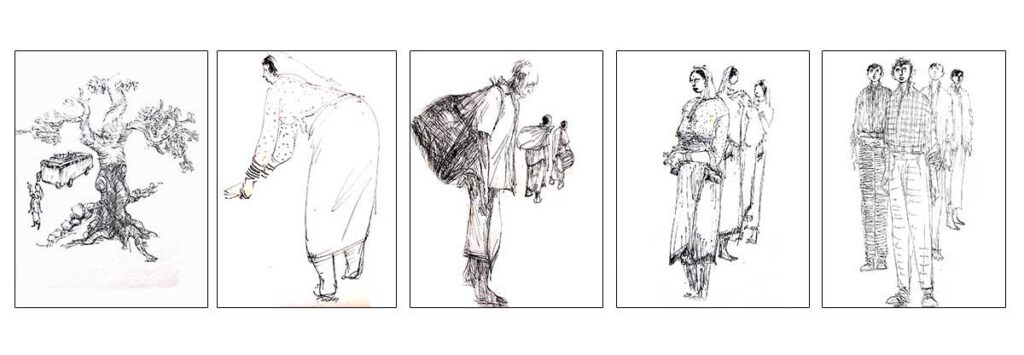C.K. Vijayalakshmi
The coir knot came undone,
Tumbling
I fell headlong
And as I cried
In the very many eyes of the cuts and bruises in the gentle breeze
Sketches and colours
(Kadammanitta – Sketches and Colours)

Some intense and resolute impulses have been the source of Chans aka. Chandrashekharan’s illustrations. Their journey is characterized by steady footsteps, unrelenting and resolute, always pacing forward. And look oddly tall and heavy. They communicate more with their body than with their face. Body language becomes the vehicle of meaning making for Chandashekharan’s illustrations.
No matter whether the character is a beedi worker or a policewoman, the story gets told through the body. And such enunciations prompt ripples of transmission in the reader, quicker than words. While the writer narrates, Chans’s illustrations weave emotions on the story.
The following comment by novelist P. Valsala should reflect this: “I have this secret wish buried in my mind about Chans illustrating my stories. I have sometimes sent stories to Deshabhimani for the sole purpose of Chans illustrating them.”

The one sentiment that is absent in Chans’s illustrations is softness. The characters thrive on their determination and live out the persona borne out of it. C.V. Balakrishnan’s comment seems to suggest this: “We might forget the story or characters but Chans’s illustrations remain etched in our minds.” He cites the illustration of a Ferris wheel presented in the backdrop of a carnival as an example. Chans had this to say about the illustration: “I have an emotional connect with that image.”
He arrived at Deshabhimani 34 years back. From then on up until now, he continues to draw for Deshabhimani.
Chans has acknowledged this political context behind the formation of his characters who are unperturbed in the corridors of feudalism and power.
However, with the age of feudalism and tyrannical figures making way for globalization, ramifications were felt in illustration art as well. Pronounced changes transformed his technique, backdrops, anatomy and even colour composition. It grew further into a nuanced enunciation. Dark shades layered the drawing with intense emotions. The illustrations were sometimes a cold stare or a baffled look, if not a delirious scream. The artist tended to draw upon mediums like geometry for instance.
When marginalized lives had to be presented, character’s legs grew thinner and physique a tad taller. Characters who otherwise had eyes to see now had a spot in its place. Fiction writer V.R. Sudhish reflects: “The characters do not want to be looking at the readers. These eyeless characters imply that if the readers wish to see the characters, they should learn to look.”
An approach of this kind is formed at the zenith of protest. But when presenting troubled lives, the characters return with intense and distressed faces. The illustrations of Gujarat riots employed a similar style. And such characters are devoid of their bodies. And it’s just the face alone. These are some of the changes that times effected on his technique.

Many share the sentiment that Chans’s firm black strokes resemble A.S. Nair’s style. That’s plausible, is the answer. But he says that he never resorted to blind imitation yet unconsciously there seems to be some affinities. What this exemplifies is his openness to and truthfulness about stylistic influences. Even with regard to questions concerning the anatomy of the characters, Chans maintains that the determination of additional height, weight and movement was made unconsciously.
Chans’s method is a far cry from romanticism. But it leans towards classical notions of style. And he proclaims his affinity for realism.
In the realm of pictorial arts, illustration for literary works is considered as a very demanding sub-genre. Limitations are plenty. Various elements such as the writer, characters, and context even the publisher place different kinds of restrictive demands on the illustrator. One should not veer away from the text and instead it is expected of the illustrator to be in close proximity with the text. Chans created his illustrations even as these constrictions existed. He proved that the illustrator can command equal attention in relation with the text. It is from the heart of the characters that he approached every story and novel. Perhaps, that’s why his illustrations conquered the hearts of his writers too. The admiration extended to K.C.S. Panicker, A.S. and Namboothiri for their literary illustrations continues into Chandrashekharan. Namboothiri feels that this is a matter of rare good fortune enjoyed only by the writers and readers of Malayalam. Such importance accorded to literary illustrations is unique to Malayalam magazines.
VARTHAMANAM (Newspaper India )